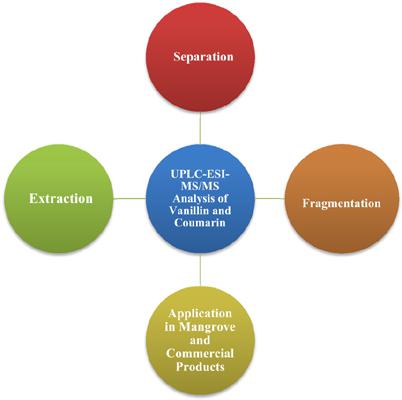Current Analytical Chemistry ( IF 1.8 ) Pub Date : 2020-08-31 , DOI: 10.2174/1573411015666190828185647 Nilesh Lakshman Dahibhate 1 , Devendra Kumar 2 , Kundan Kumar 1

|
Background: Vanillin is a key constituent of natural vanilla. Usage of natural vanilla is affected due to its high price and limited supply, which leads to the use of artificial vanilla flavoring substances. Coumarin is a commonly encountered adulterant in beverage, food, and cosmetics as a flavoring and fragrance enhancer. However, coumarin has been banned for use as a food additive due to its toxic effects. To comply with the quality of vanillin in food and food products needs to be ensured.
Methods: A rapid, simple and selective analytical method has been developed and validated using ultra-high performance liquid chromatography-tandem mass spectrometry for quantitative analysis of vanillin and coumarin. We also optimized fragmentation pattern of these metabolites while increasing collision energy to elucidate its structural information. The suitability and robustness of the method was checked by Zorbax Eclipse XDB C8 column (4.6 × 150 mm, 5 μm) using mobile phase comprising of methanol (A) and water with 0.1% formic acid (B) (90:10) with a flow rate 200 μL/min. The separation was achieved within 4.2 min with total run time of 5.0 min. The analysis was done by multiple reaction monitoring using 153/93 and 147/91 pair transition in positive electrospray ionization for vanillin and coumarin respectively.
Results: The lower limit of quantification of vanillin and coumarin was 0.39 ng/mL and 3.9 ng/mL respectively. The intra and inter-day precisions for vanillin and coumarin were lower than 8.87 and 8.62 whereas, accuracy was within ± 2.13 and ± 1.53 respectively. The vanillin and coumarin was found to be stable under the examined conditions. This method was successfully applied for quantification of vanillin and coumarin in mangrove species and commercial food products.
Conclusion: The described method and fragmentation pattern could be useful to direct confirmation and quality monitoring of a commercial food products assimilated with vanillin.
中文翻译:

使用UPLC-ESI-MS / MS同时分析红树林植物和商业食品中的香兰素和香豆素
背景:香兰素是天然香草的关键成分。天然香草的使用由于其高价格和有限的供应而受到影响,这导致了人造香草调味剂的使用。香豆素是饮料,食品和化妆品中常见的掺假剂,可作为增香剂和增香剂。然而,由于其毒性作用,香豆素已被禁止用作食品添加剂。为了确保食品和食品中香兰素的质量,必须确保。
方法:建立了一种快速,简单,选择性的分析方法,并使用超高效液相色谱-串联质谱法对香兰素和香豆素进行了定量分析。我们还优化了这些代谢物的片段化模式,同时增加了碰撞能量以阐明其结构信息。使用Zorbax Eclipse XDB C8色谱柱(4.6×150 mm,5μm),使用甲醇(A)和水与0.1%甲酸(B)(90:10)的流动相进行色谱法检查该方法的适用性和稳健性。流速200μL/ min 在4.2分钟内完成分离,总运行时间为5.0分钟。通过分别使用香草醛和香豆素的正电喷雾电离中的153/93和147/91对过渡进行多反应监测来进行分析。
结果:香兰素和香豆素的定量下限分别为0.39 ng / mL和3.9 ng / mL。香兰素和香豆素的日内和日间精度均低于8.87和8.62,而精度分别在±2.13和±1.53之内。发现香兰素和香豆素在所检查的条件下是稳定的。该方法已成功用于红树林物种和商业食品中香兰素和香豆素的定量。
结论:所描述的方法和片段化模式可用于指导确认和质量监测与香兰素同化的商业食品。



























 京公网安备 11010802027423号
京公网安备 11010802027423号